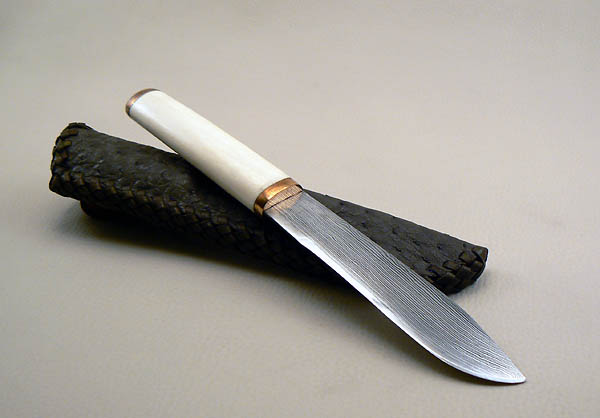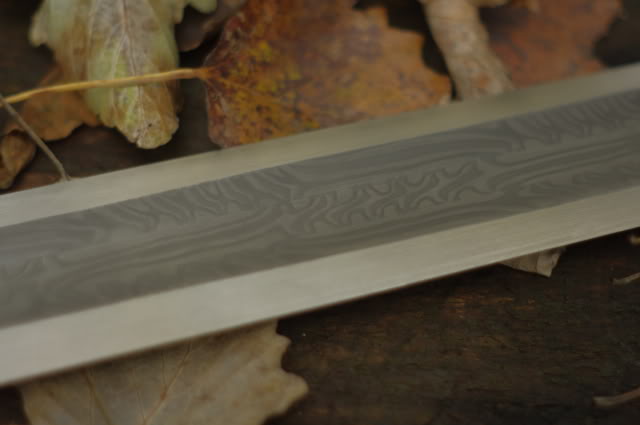I have done some searching but its still not obvious to me why there often (if not always) are really straight looking boundaries between twisted bars, & also between twisted bars & edge steel. I would have assumed (knowing very little) that the welding process was pretty messy, & so would not look so straight & neat. I am mainly referring to modern reproductions, where it shows so clearly.
Is it simply that the bars are ground flat after twisting, prior to welding, or...?
Sorry for the (likely very) dumb question. Thanks!
Have you seen a series of pictures at the bottom of the Armart page with their pattern welded swords? It helps in imagining how the process goes...
http://www.armart.antiquanova.com/Viking_pattern_welded.htm
http://www.armart.antiquanova.com/Viking_pattern_welded.htm
Here's a link to a WIP by a French bladesmith that should answer your question:
http://forums.dfoggknives.com/index.php?showtopic=14400
http://forums.dfoggknives.com/index.php?showtopic=14400
Hello,
yes you are right, the bars are ground flat after twisting, prior to welding. Moreover, sometimes a thin layer of plain steel in inserted between each bar, in order to make thicker and more visible boundaries.
There is no need to provide a lot of strength in the welding process of the bars. When doing it carefully, the welding lines can remain quite straight.
To show you how the forging may keep the inside pattern "safe", here is a blade made by widthwise forging of a simple layered bar. You can see that all the layers remain pretty straight.
 Attachment: 36.65 KB
Attachment: 36.65 KB

yes you are right, the bars are ground flat after twisting, prior to welding. Moreover, sometimes a thin layer of plain steel in inserted between each bar, in order to make thicker and more visible boundaries.
There is no need to provide a lot of strength in the welding process of the bars. When doing it carefully, the welding lines can remain quite straight.
To show you how the forging may keep the inside pattern "safe", here is a blade made by widthwise forging of a simple layered bar. You can see that all the layers remain pretty straight.

Think of it this way: straight lines are just one pattern that can be put into pattern welding and they're the foundation of pattern welding. You're seeing the layers that go into pattern welding and they haven't been twisted/manipulated into some other pattern.
I think Carl talks about lines between different rods in the pattern welded core, for example three rods visible in the core of a Hanwei Saxon, not lines between the layers.


Luka is correct about my question, & shows a good example. Here is another, & there are many more, where the lines look really, really, (really!) straight.
http://www.templ.net/pics-weapons/104-sword/1...lade-v.jpg
However, the closeups shown in below (got there by way of RD's interesting D.Fogg link), especially the 2nd pic down, show that the lines are not always so straight, & wander around some. This is more what I would have expected to be typical, figuring the welding process is messy.
http://www.elfic.fr/anglais/pages/viking-sword.htm
So far (I think) I learned that the really really straight cases were ground very flat after twisting, prior to welding. I'd guess the less straight, wandering, & more random cases were not ground so much (correct me if I'm wrong). Does the latter wandering case make the welding work much more tricky?
http://www.templ.net/pics-weapons/104-sword/1...lade-v.jpg
However, the closeups shown in below (got there by way of RD's interesting D.Fogg link), especially the 2nd pic down, show that the lines are not always so straight, & wander around some. This is more what I would have expected to be typical, figuring the welding process is messy.
http://www.elfic.fr/anglais/pages/viking-sword.htm
| Bernard Delor wrote: |
|
yes you are right, the bars are ground flat after twisting, prior to welding. Moreover, sometimes a thin layer of plain steel in inserted between each bar, in order to make thicker and more visible boundaries. |
So far (I think) I learned that the really really straight cases were ground very flat after twisting, prior to welding. I'd guess the less straight, wandering, & more random cases were not ground so much (correct me if I'm wrong). Does the latter wandering case make the welding work much more tricky?
How straight the weld lines between rods/billets are in the finished blade depends a lot on how they are forged. Some styles are often anything but straight, while other demand pretty straight lines.
Twisted bars can be forged square to pretty tight tolerances, or (and) ground flat (and clean) prior to final welding. This can have an impact on final straightness, but so will also amount and type of forging of the final billet after final welding. A lot of shaping and manipulation of width/thickness & shape can cause process of forging leaving undulating lines. Not always, but sometimes.
You do not always want/need a lot of forging after the billet/blank is welded for the last time. It depends (again).
Twisted bars can also be welded together to a blade blank without prior square forging and/or grinding. Then you will see some slight undulating lines between the rods. Sometimes. Depends on how much the billet is ground to reveal the pattern.
I will not pretend to be an expert on pattern welding. But this is according to my own (rather limited) experience and from seeing the work of others, both contemporary and ancient smiths.
Straight lines can be a proof of good hammer control and/or careful cleaning/grinding of the billets. To get straight lines you have to forge evenly and carefully. It takes a bit of hammer control and the ability to keep the work square and even through out the process.
Sometimes you do want a bit of organic undulation and irregular thickness of the layers as this is a very common thing to see on originals. Not all, but some and it can be a very characteristic feature.
Twisted bars can be forged square to pretty tight tolerances, or (and) ground flat (and clean) prior to final welding. This can have an impact on final straightness, but so will also amount and type of forging of the final billet after final welding. A lot of shaping and manipulation of width/thickness & shape can cause process of forging leaving undulating lines. Not always, but sometimes.
You do not always want/need a lot of forging after the billet/blank is welded for the last time. It depends (again).
Twisted bars can also be welded together to a blade blank without prior square forging and/or grinding. Then you will see some slight undulating lines between the rods. Sometimes. Depends on how much the billet is ground to reveal the pattern.
I will not pretend to be an expert on pattern welding. But this is according to my own (rather limited) experience and from seeing the work of others, both contemporary and ancient smiths.
Straight lines can be a proof of good hammer control and/or careful cleaning/grinding of the billets. To get straight lines you have to forge evenly and carefully. It takes a bit of hammer control and the ability to keep the work square and even through out the process.
Sometimes you do want a bit of organic undulation and irregular thickness of the layers as this is a very common thing to see on originals. Not all, but some and it can be a very characteristic feature.
Confessions of a bladesmith; secrets revealed!
Kevin R. Cashen
http://forums.swordforum.com/showthread.php?t=13809
Kevin walks through the making of one of these twisted and edge welded examples.
Cheers
GC
Kevin R. Cashen
http://forums.swordforum.com/showthread.php?t=13809
Kevin walks through the making of one of these twisted and edge welded examples.
Cheers
GC
Page 1 of 1
You cannot post new topics in this forumYou cannot reply to topics in this forum
You cannot edit your posts in this forum
You cannot delete your posts in this forum
You cannot vote in polls in this forum
You cannot attach files in this forum
You can download files in this forum
All contents © Copyright 2003-2006 myArmoury.com — All rights reserved
Discussion forums powered by phpBB © The phpBB Group
Switch to the Full-featured Version of the forum
Discussion forums powered by phpBB © The phpBB Group
Switch to the Full-featured Version of the forum